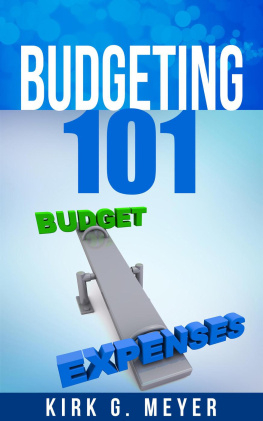PROJECTING ENVIRONMENTAL TRENDS FROM ECONOMIC FORECASTS
Projecting Environmental Trends from Economic Forecasts
Peter B. Meyer
Thomas S. Lyons
Tara L. Clapp
Center for Environmental Policy and Management, College of Business and Public Administration, University of Louisville
First published 2000 by Ashgate Publishing
Reissued 2018 by Routledge
2 Park Square, Milton Park, Abingdon, Oxon OX14 4RN
711 Third Avenue, New York, NY 10017, USA
Routledge is an imprint of the Taylor & Francis Group, an informa business
Copyright Peter B. Meyer, Thomas S. Lyons and Tara L. Clapp 2000
All rights reserved. No part of this book may be reprinted or reproduced or utilised in any form or by any electronic, mechanical, or other means, now known or hereafter invented, including photocopying and recording, or in any information storage or retrieval system, without permission in writing from the publishers.
Notice:
Product or corporate names may be trademarks or registered trademarks, and are used only for identification and explanation without intent to infringe.
Publisher's Note
The publisher has gone to great lengths to ensure the quality of this reprint but points out that some imperfections in the original copies may be apparent.
Disclaimer
The publisher has made every effort to trace copyright holders and welcomes correspondence from those they have been unable to contact.
A Library of Congress record exists under LC control number: 00133522
ISBN 13: 978-1-138-72610-9 (hbk)
ISBN 13: 978-1-315-19158-4 (ebk)
Financial support for the study on which this volume is based was provided through a grant from the Regional and State Planning Division, Office of Program Planning and Evaluation, U.S. Environmental Protection Agency to the Kentucky Long Term Policy Research Center. Michael Childress, the Executive Director of the Center, recruited us for the project and offered essential direction, assistance and support. The University of Louisville and its Kentucky Institute for the Environment and Sustainable Development provided further funds and support, expanding the scope of the project.
The Tellus Institute in Boston provided us with the Stockholm Enviro nm ent Institute's POLESTAR program for environmental forecasting, along with excellent support from Steve Bernow and Charlie Heaps. In Kentucky, Nancy Fouser of the Natural Resources and Environmental Protection Cabinet worked tirelessly to find us data, while Perry Nutt of the Legislative Research Commission manipulated the state's econometric forecasting model, helping to quantify our projections.
Steve Keach of the U.S. EPA provided resource materials from other relevant activities of the EPA. Our colleagues in the Kentucky Institute for the Environment and Sustainable Development offered additional data and served as reality testers for our projections and forecasts. We are especially indebted to Alan Dittmer, Russ Prough, Hugh Spencer, Jan Stevenson and David Wicks, who assisted us with the conduct of the advisory group sessions that helped to focus the project. The forty-odd participants in these sessions shaped the whole project.
For assistance with the preparation of this book, we would like to thank Angela Keene and Stefanie Shull. Sarah Markham of Ashgate Publishing gave her patient and professional support to the completion of this volume.
With thanks to all, we offer our findings. Despite our overwhelming debts to so many others, we alone are responsible for these conclusions.
The purpose of this book is to outline a forecasting method targeted at changing current policy in the direction of sustainability; a method that bridges the gap between the goal of sustainable development and the barriers faced in the implementation of sustainable development. The forecasting techniques can be used to estimate the environmental impacts of economic policy choices in the medium term; the evaluation of current possible alternative paths is the most achievable forecasting goal. The mix of techniques we illustrate, and the attention to barriers to acceptance and implementation, are central to producing information with the potential to influence current choices towards more environmentally sustainable economic policies.
The concept of sustainable development is gaining currency in many, if not most, policy contexts. The concept of sustainable development emphasizes a balanced relationship between ecology, economy and social life, for current and future generations. Since its introduction by the Brundtland Commission (WCED 1987), in its broad outlines sustainable development has become an accepted vision of a development outcome. The implication of a sustainable development vision implies that choices in any one area require the assessment of consequences in the others.
However, in many political contexts there are many barriers to planning for sustainability. First of all, there are differences, some of which are quite deep, in concepts of the defining conditions of sustainable development. These differences are akin to different views of a "good life," or a "good society." Policy is made on some middle ground of current accepted views held by policy makers and politicians (Fiorino 1995). Sustainable development offers a vision of the future; a normative goal against which we can compare the many possible undesirable futures. The acceptable means by which sustainable development might be achieved are dependent on the capacity for concerted and integrated actions, the legitimacy of public intervention, ideas of justice and individual freedom, as well as accepted concepts of resource scarcity.
The lack of consensus over the procedural and substantive norms of sustainable development presents a barrier to the implementation of sustainable development policy. Some writers have described an "environmental policy paradox"; in this view, the substantive changes that need to be made are clear. The paradox is that despite widely held consensus over needed policy changes, implementation is both slow and difficult (Smith 1992). In our work, we found not only a lack of consensus over goals, but a resistance among policy makers to both planning and to environmentalism as well. In part, this was in response to economic concerns over a potential tradeoff between prosperity and environmental protection.
Other barriers to planning for sustainability can be seen as a product of uncertainty or a lack of information. Problems are complex, and the assessment of future consequences is uncertain. However, the lack of reliable information about the future is a permanent feature of the policy landscape. Information is used to make policy decisions which is found to be sufficiently reliable and well founded. Judgments about the sufficiency and quality of information in public discourse can be based upon the extent to which that information is in accord with prevalent political views and the character and reliability of its source, just as much as more technical judgments of methodological quality. Decisions are made, typically, using the information that is available and least contested. These incremental decisions about economic strategy, social policy and ecological health are made in existing policy contexts. The policies chosen in the existing policy contexts, whether based on explicit concern for some view of sustainability or not, together constitute a policy direction.







